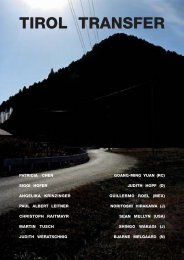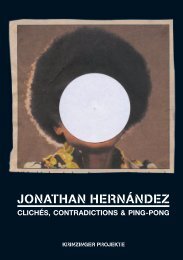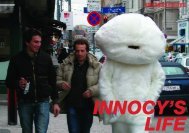post_modellismus – models in art - krinzinger projekte - Galerie ...
post_modellismus – models in art - krinzinger projekte - Galerie ...
post_modellismus – models in art - krinzinger projekte - Galerie ...
You also want an ePaper? Increase the reach of your titles
YUMPU automatically turns print PDFs into web optimized ePapers that Google loves.
S<strong>in</strong>ce the photographs depict <strong>models</strong> of<br />
reality and not reality itself, they not only<br />
irritate the assumption of what is superficially<br />
evident and visible but even the<br />
prototypical prerequisites of photographic<br />
production and reception. Or to<br />
put it differently: These pictures of <strong>models</strong><br />
recall that photography itself can only<br />
establish the model case of a possible<br />
reality, mean<strong>in</strong>g and conception.<br />
The reality that appears <strong>in</strong> Laurie<br />
Simmons’ photographs is a dollhouse <strong>in</strong><br />
a literal sense. It consists of figures and<br />
objects the <strong>art</strong>ist found <strong>in</strong> toy shops <strong>in</strong><br />
the country: ‘toys that I’d had as a child,<br />
toys I’d gotten for Christmas <strong>–</strong> the same<br />
dollhouse, the same dolls, board games,<br />
tea sets. Not just similar <strong>–</strong> the very same<br />
brands and boxes that I had played with.’ 3<br />
In the mid-1970s Laurie Simmons used<br />
these toy figures to create her first photographic<br />
pieces. She arranged scenes<br />
around the protagonists of female figures<br />
whose range of action was limited<br />
to the <strong>in</strong>teriors of the kitchen, liv<strong>in</strong>g room,<br />
d<strong>in</strong><strong>in</strong>g room and bath room. By means<br />
of commercially available dollhouse <strong>in</strong>teriors<br />
and figures the <strong>art</strong>ist created<br />
motives and spaces of action that appear<br />
both playful and oppressive: ‘I th<strong>in</strong>k a k<strong>in</strong>d<br />
of play act<strong>in</strong>g was go<strong>in</strong>g on, sett<strong>in</strong>g up<br />
these th<strong>in</strong>gs, that was less about the<br />
fact of play<strong>in</strong>g and more about the<br />
recreation of a sense of visual memory<br />
or history.’ 4<br />
This visual memory and its prototypical<br />
manifestation creates the foundation for<br />
Simmons’ photographs: The <strong>models</strong> for<br />
her photographs are take from illustrated<br />
press and TV programs, the advertisement<br />
<strong>in</strong>dustry and daily soap operas<br />
from that time. The poses of her protagonists<br />
are those of <strong>in</strong>dustrially created<br />
model figures, props and accessories<br />
from the 1950s. The dollhouse after<br />
which Simmons modeled her first series<br />
of photographs corresponds, as said<br />
above, exactly to the dollhouse of her<br />
childhood. The arranged scenes and<br />
habitats, however, do not just illustrate<br />
biographic sketches but rather reveal<br />
collective patterns and stereotypes,<br />
which were <strong>in</strong>fluential for the middleclass<br />
society of the 1950s and early<br />
1960s <strong>in</strong> the United States: ‘It’s a generalized<br />
memory’, as the <strong>art</strong>ist said, ‘it’s of a<br />
p<strong>art</strong>icular generation, and a p<strong>art</strong>icular way<br />
of grow<strong>in</strong>g up <strong>in</strong> a homogenized environment.’<br />
5 That Laurie Simmons deliberately<br />
works with the possibilities of photographic<br />
representation has to do with<br />
the powerful authority of the reproductive<br />
media, which have sought to implement<br />
certa<strong>in</strong> <strong>models</strong> of reality not just<br />
aesthetically but also socially and politically.<br />
Here Simmons is aim<strong>in</strong>g at noth<strong>in</strong>g<br />
less than a politics of representation.<br />
Assum<strong>in</strong>g that the photographic image<br />
11









